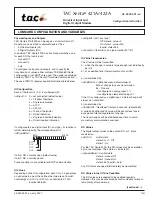
6-1
29084-05 03/17
VERSALIFT VST-7500-I
DAIL
Y
VISUAL
INSPECTION
Torque-Seal Mark In Misalignment Condition
Figure 6.2
WELDS
- Refer to the “Critical Welds” drawing in
this section. All the welds should be inspected for
signs of fatigue. Rust and hairline cracks on a weld
indicate weld fatigue.
HYDRAULIC LINES
- Hydraulic lines should be
inspected for loose connections and frayed jackets.
Carefully examine the hoses, especially any portion
of hose subject to flexing and particularly the hoses
at the platform.
OIL LEAKS
- Oil leaking onto the truck floor or the
ground is sign of an impending problem. A hydraulic
leak will create a slippery surface which is potentially
hazardous. Hydraulic leaks must be repaired by
qualified service personnel and the unit must be
cleaned of excess hydraulic oil. If a hydraulic leak is
not repaired the oil in the reservoir will be depleted
and pump damage may occur.
ELECTRICAL SYSTEM
- Inspect electrical system
for damaged components. Check for bare electrical
wires and remove any trash or debris from around
elctrical components. Repair all damaged wires and
secure any loose electrical components or wires.
VEHICLE TIRES
- Check tires for the correct inflation
and for damage. Low pressure or damaged tires
are unsafe while driving the vehicle or operating the
lift.
LOOSE OBJECTS
- Inspect the booms for loose
objects (tools, spare parts, etc.) that might fall when
the booms are elevated.
HYDRAULIC OIL LEVEL
- The hydraulic fluid level
can be easily checked by monitoring the oil level
through the sight gauge. Add hydraulic oil if
necessary.
CONTROLS
- Operate all the lift controls through
the full range of motion to verify the controls are
functioning properly.
EXTENSION SYSTEM
- While operating the unit
from the lower controls, observe the extension
system during operation. First, raise the outer/inner
This aerial lift is designed to provide years of reliable
service with minimum maintenance. A routine
preventive maintenance program will assure
extended aerial lift service. The operator is
responsible for detecting maintenance problems
during the daily visual inspection, reporting the need
for adjustments or repairs, verifying that maintenance
is performed at the suggested intervals, and
determining if the aerial lift is in a good, safe operating
condition. The importance of accurate maintenance
records cannot be over emphasized. In order to judge
the condition of the aerial lift, the operator needs to
be familiar with the maintenance records of the aerial
lift. Refer to the “Maintenance Checklist” in Service
Procedures Section of the Service Manual for the
suggested interval inspection information. The actual
repair or adjustment must be done by a qualified
aerial lift mechanic.
Every day the equipment must be given a thorough
visual inspection to detect problems before they
become serious. During this inspection the operator
shall look for anything out of the ordinary that might
indicate a problem. Particular attention must be paid
to the following items. The Daily Visual Inspection
Checklist included in this section must be followed.
BOLTS
- Critical fasteners are identified on the
“Critical Fasteners” drawing in this section. All major
sections of the
Versalift
are bolted together and it is
vital that these bolts remain tight. Visually inspect all
the bolts for signs of relative movement. Pay
particular attention to the load supporting bolts
(rotation bearing bolts, pedestal/subframe mounting
bolts, platform rotator bolts). Critical bolts are Torque-
Seal marked to provide a quick means of detecting
any turning. Do not use the lift if the Torque-Seal
mark between the bolt head and mounting surface,
are not in alignment. Refer to Maintenance and
Inspection Schedule in Service Procedures Section
of the Service Manual for recommended torque
procedures and torque chart specifications. Refer
to Figure 6.1 and 6.2 for Torque Seal mark conditions.
Torque-Seal Mark In Acceptable Condition
Figure 6.1
DAILY VISUAL INSPECTION
Summary of Contents for VERSALIFT VST-7500-I
Page 2: ......
Page 4: ......
Page 6: ......
Page 8: ...1 2 29084 05 03 17 VERSALIFT VST 7500 I INTRODUCTION Figure 1 1 Model VST 7500 I Nomenclature...
Page 11: ...2 3 29084 05 03 17 VERSALIFT VST 7500 I RESPONSIBILITIES SAFETY...
Page 12: ...2 4 RESPONSIBILITIES SAFETY 29084 05 03 17 VERSALIFT VST 7500 I...
Page 13: ...2 5 29084 05 03 17 VERSALIFT VST 7500 I RESPONSIBILITIES SAFETY...
Page 24: ...3 6 29084 05 03 17 VERSALIFT VST 7500 I SPECIFICATIONS...
Page 25: ...3 7 29084 05 03 17 VERSALIFT VST 7500 I SPECIFICATIONS...
Page 27: ...3 9 29084 05 03 17 VERSALIFT VST 7500 I SPECIFICATIONS...
Page 28: ......
Page 42: ......
Page 50: ...6 4 29084 05 03 17 VERSALIFT VST 7500 I DAILY VISUAL INSPECTION...
Page 51: ...6 5 29084 05 03 17 VERSALIFT VST 7500 I DAILY VISUAL INSPECTION...
Page 52: ...6 6 29084 05 03 17 VERSALIFT VST 7500 I DAILY VISUAL INSPECTION...






































